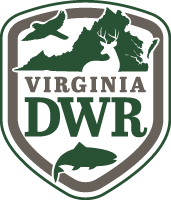Wild turkeys, once pushed to the brink of extinction, represent one of North America’s landmark conservation success stories. Today’s healthy wild turkey populations provide many benefits for hunters, outdoor recreationists, and the general public, but may also foster concerns for crop damage, vehicle collisions, or conflicts within residential neighborhoods.
Concerns over turkey populations have risen over the past several years which provides some uncertainty and challenges for future management. With varied public values and opinions about wild turkeys (even among hunters), turkey management continues to provide challenges for the Virginia Department of Wildlife Resources (DWR) in their mission to Conserve, Connect, and Protect. Optimum turkey populations will balance positive demands (e.g., hunting, viewing) with negative demands (e.g., agricultural damage, other conflicts).
Embodying the interests of all citizens, the first Virginia Wild Turkey Management Plan (2013–2022) was developed using a stakeholder involvement process to reflect the values of a diverse public about what should be accomplished with turkey management in Virginia. A similar approach was undertaken for this revision of the turkey management plan. Public stakeholders interested in turkeys made value choices about turkey management, while wildlife professionals focused on technical and biological aspects. While considering technical background information from DWR staff from throughout Virginia, a citizen Stakeholder Advisory Committee (SAC) met three times to develop the goals and objectives found in the Virginia Wild Turkey Management Plan. The SAC, initially comprised of 18 individuals from key stakeholder groups, represented various turkey-related interests from across the state, including private landowners, public land managers, sporting interests (e.g., fall hunters, spring hunters), non-governmental organizations, recreational interests, and agricultural producers.
The Turkey Technical Committee, involving DWR staff with technical expertise in turkey management, provided scientific and technical information. In addition to providing technical feedback to the SAC, the Turkey Technical Committee also focused on identifying the objectives and potential strategies to achieve the goals drafted by the SAC.
The Virginia Wild Turkey Management Plan contains four sections: History, Demand, Accomplishments of the Previous Plan, and the Values, Goals, Objectives, and Strategies. The technical portion (History and Demand Sections) describes wild turkey management history, life history and biology, and status (supply and demand) in Virginia. The accomplishments of the previous plan section provide an assessment of DWR’s progress towards meeting goals and objectives outlined in the previous management plan. The Virginia Wild Turkey Management Plan includes an overarching mission statement for managing turkeys and four goal areas that address populations, habitat, recreation, and human-turkey conflict. Specific objectives were developed to help guide the attainment of each goal. Potential strategies suggest ways that each objective might be achieved.
Read the Virginia Wild Turkey Management Plan 2025–2034Turkey Plan Mission Statement & Goals
Sustainably manage wild turkey populations as a wild, free-roaming public trust resource in a manner that serves the needs and interests of the citizens of the Commonwealth. Manage wild turkey populations, turkey habitat, turkey-related recreation, and human-turkey conflicts, using biologically sound, applied science-based approaches that:
- are ethical;
- are flexible, innovative, and cost effective;
- are proactive;
- are publicly accepted (i.e. informed acceptance);
- have impacts at relevant scales (local, region, state);
- are accountable and transparent;
- are collaborative with other agencies, partners, and the public; and,
- are holistic, considering consequences on other species and stakeholders.
The specific goals address:
Populations:
Manage turkey populations at levels adaptable to changing landscapes that balance the varied needs and expectations of stakeholders statewide and locally. The use of regulated hunting and active habitat management should be the primary population management tools while acknowledging that other management tools may be employed depending upon localized objectives or limiting factors.
Habitat:
Manage turkey habitat compatible with turkey population, recreation, and conflict goals while working across diverse public and private land ownerships and ecosystems. Habitat conservation actions should consist of practices that benefit multiple species with an emphasis on areas of special significance to the life history of turkeys (e.g., nesting or brood rearing habitat) while also considering potential impacts of other landscape changes (e.g., land use or climate impacts).
Recreation:
Provide and promote various forms of wild turkey-related recreation to optimize quality opportunities (i.e. safe, responsible, ethical, lawful, and accessible). Preserve the heritage and tradition of hunting turkeys (fall and spring), and provide opportunities to observe turkeys, for both management and recreational benefits. Turkey-related recreational opportunities should not prevent the attainment of population objectives.
Conflict:
Prevent and reduce human—wild turkey conflicts (e.g., agricultural, residential, recreational, airport) while:
- promoting shared responsibility (personal, community, agency)
- fostering practices that keep turkeys wild
- prioritizing use of nonlethal methods to resolve conflicts
- using regulated hunting as the preferred method when lethal alternatives are required to manage conflicts
- attaining turkey population, habitat, and recreation goals
This second Wild Turkey Management Plan intends to build off the success of the first plan, guiding management direction and providing clarity to management strategies that DWR and partners should employ to achieve lasting success for turkey management. The Plan identifies generally what, when, and how turkey projects are implemented and will provide guidance to the DWR Board of Directors, DWR administrators and staff, and the public on turkey program priorities, management activities, hunting regulations, and annual budgeting for the next 10 years. It is important to emphasize that (1) the Plan is strategic rather than operational, and (2) turkey management is the shared responsibility of DWR, other agencies, partners, and the public.
Read the Virginia Wild Turkey Management Plan 2025–2034
